The Organic Drinks Market is estimated to be valued at USD 23.6 billion in 2025 and is projected to reach USD 32.9 billion by 2035, registering a compound annual growth rate (CAGR) of 3.4% over the forecast period.
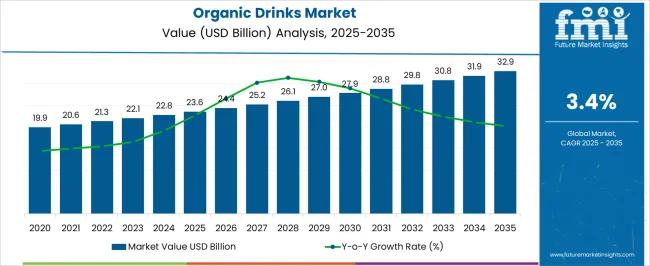
| Metric | Value |
|---|---|
| Organic Drinks Market Estimated Value in (2025 E) | USD 23.6 billion |
| Organic Drinks Market Forecast Value in (2035 F) | USD 32.9 billion |
| Forecast CAGR (2025 to 2035) | 3.4% |
The organic drinks market is witnessing rapid expansion as consumer preferences shift toward healthier, sustainable, and environmentally responsible beverage choices. Growing awareness of the harmful effects of artificial additives, preservatives, and chemical-based farming practices has driven demand for beverages made from certified organic ingredients. The market is also benefiting from rising disposable incomes, lifestyle changes, and the growing trend of preventive healthcare, which is encouraging consumers to choose drinks that provide functional benefits alongside refreshment.
Investments in innovative processing technologies, transparent labeling, and eco-friendly packaging solutions are further shaping the competitive landscape. The entry of mainstream beverage companies into the organic drinks space, coupled with increasing retail penetration across supermarkets, health stores, and online channels, is expanding product accessibility.
Government regulations promoting organic farming and consumer trust in certifications are providing additional momentum As sustainability becomes a key decision-making factor, the market is expected to maintain strong growth, with producers focusing on new formulations, flavor diversity, and enhanced shelf-life solutions to meet the evolving needs of global consumers.
The organic drinks market is segmented by type, source, technology, sales channel, and geographic regions. By type, organic drinks market is divided into Soft Drinks, Hot Drinks, Organic Tea, Organic Coffee, and Others. In terms of source, organic drinks market is classified into Organic Fruits and Organic Vegetables. Based on technology, organic drinks market is segmented into High-Pressure Processing and Pulse Electric Field Treatment. By sales channel, organic drinks market is segmented into Retailers, Online Retailers, Wholesalers, and Distributors. Regionally, the organic drinks industry is classified into North America, Latin America, Western Europe, Eastern Europe, Balkan & Baltic Countries, Russia & Belarus, Central Asia, East Asia, South Asia & Pacific, and the Middle East & Africa.
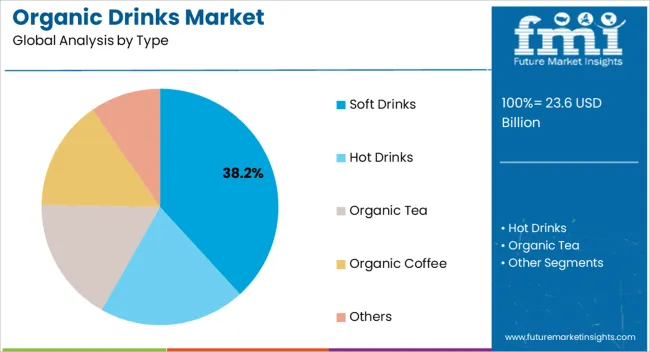
The soft drinks segment is projected to hold 38.2% of the organic drinks market revenue share in 2025, making it the leading type category. This leadership is being driven by the widespread consumer appeal of soft drinks, combined with the growing demand for healthier alternatives free from synthetic additives and artificial sweeteners. Organic soft drinks are benefiting from their ability to provide familiar flavors and refreshment while aligning with clean-label trends.
Rising demand for carbonated organic beverages, flavored waters, and fruit-based sodas is further strengthening the segment’s presence across multiple demographics, particularly among younger consumers seeking natural and innovative beverage options. The segment’s accessibility through mainstream retail outlets and online platforms has widened its adoption globally.
In addition, manufacturers are investing in premium organic formulations, reduced sugar content, and natural flavor infusions to attract health-conscious consumers The ability to balance indulgence with nutritional benefits is reinforcing the dominance of organic soft drinks, ensuring they remain the most influential product type within the market.
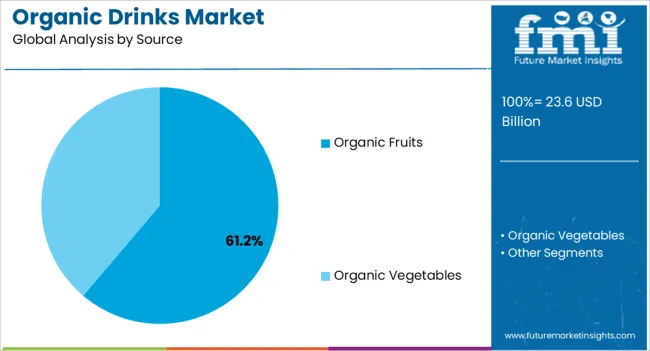
The organic fruits source segment is expected to account for 61.2% of the organic drinks market revenue share in 2025, establishing it as the leading source category. Its leadership is being attributed to strong consumer trust in fruit-based beverages, which are widely associated with naturalness, nutrition, and functional health benefits. Increasing global availability of certified organic fruits, combined with advancements in supply chain management and cold storage, is enabling consistent production of high-quality fruit-based drinks.
Demand is also being reinforced by the growing popularity of juices, smoothies, and functional beverages that highlight organic fruits as a core ingredient. The segment’s strength lies in its alignment with consumer perceptions of wellness, offering vitamins, minerals, and antioxidants in a natural format.
Additionally, fruit-based drinks allow manufacturers to diversify flavors and formulations, creating differentiation in a competitive market As demand for clean-label, nutrient-rich beverages continues to rise, the organic fruits source segment is expected to remain the most significant contributor to overall market growth.
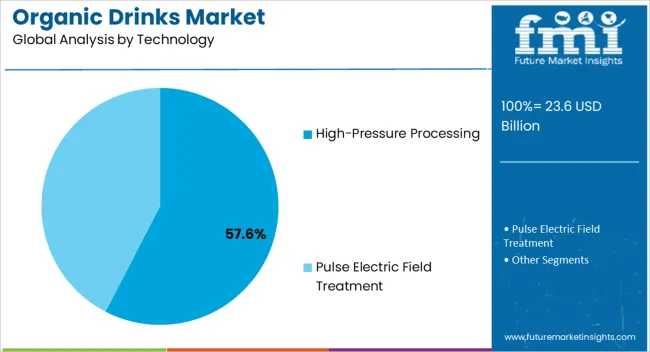
The high-pressure processing technology segment is projected to hold 57.6% of the organic drinks market revenue share in 2025, making it the leading technology category. Its leadership is being reinforced by the ability to extend shelf life while preserving the nutritional integrity, flavor, and freshness of organic drinks. Unlike traditional thermal processing, high-pressure processing ensures that the natural qualities of fruits and vegetables remain intact, appealing to consumers seeking minimally processed beverages.
The growing adoption of this technology by beverage manufacturers is being driven by rising demand for clean-label products with no artificial preservatives. It also enables global distribution without compromising product quality, which is critical for expanding into new markets.
The technology’s capacity to support diverse product formats, including juices, smoothies, and flavored waters, adds further growth potential As consumers prioritize safety, freshness, and authenticity in their drink choices, high-pressure processing is expected to remain the dominant technology, providing a strong competitive advantage to producers in the organic drinks market.
Organically grown foods are food straight from a plant that has not undergone inorganic procedures, like pesticides, fertilizers, or insecticides.
This serves to demonstrate that some food products are entirely organic, while others are. High-pressure processing methods, no thermal preservation, and sterilizing processes are used to preserve organic beverages. This method aids in the preservation of the vitamins, minerals, and enzymes included in organic beverages. Additionally, it aids in extending shelf life. Coffee is often served hot, although organic drinks like juice can be served both hot and cold.
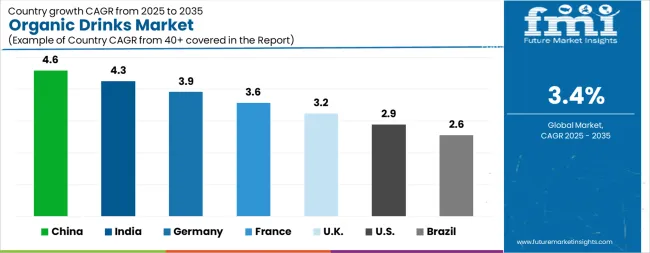
| Country | CAGR |
|---|---|
| China | 4.6% |
| India | 4.3% |
| Germany | 3.9% |
| France | 3.6% |
| UK | 3.2% |
| USA | 2.9% |
| Brazil | 2.6% |
The Organic Drinks Market is expected to register a CAGR of 3.4% during the forecast period, exhibiting varied country level momentum. China leads with the highest CAGR of 4.6%, followed by India at 4.3%. Developed markets such as Germany, France, and the UK continue to expand steadily, while the USA is likely to grow at consistent rates. Brazil posts the lowest CAGR at 2.6%, yet still underscores a broadly positive trajectory for the global Organic Drinks Market. In 2024, Germany held a dominant revenue in the Western Europe market and is expected to grow with a CAGR of 3.9%. The USA Organic Drinks Market is estimated to be valued at USD 8.6 billion in 2025 and is anticipated to reach a valuation of USD 11.5 billion by 2035. Sales are projected to rise at a CAGR of 2.9% over the forecast period between 2025 and 2035. While Japan and South Korea markets are estimated to be valued at USD 1.1 billion and USD 652.7 million respectively in 2025.
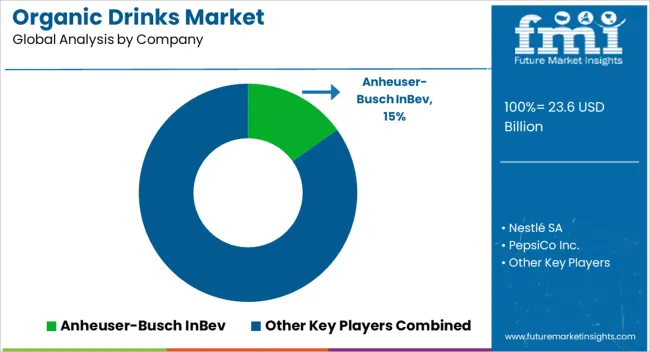
| Item | Value |
|---|---|
| Quantitative Units | USD 23.6 Billion |
| Type | Soft Drinks, Hot Drinks, Organic Tea, Organic Coffee, and Others |
| Source | Organic Fruits and Organic Vegetables |
| Technology | High-Pressure Processing and Pulse Electric Field Treatment |
| Sales Channel | Retailers, Online Retailers, Wholesalers, and Distributors |
| Regions Covered | North America, Europe, Asia-Pacific, Latin America, Middle East & Africa |
| Country Covered | United States, Canada, Germany, France, United Kingdom, China, Japan, India, Brazil, South Africa |
| Key Companies Profiled | Anheuser-Busch InBev, Nestlé SA, PepsiCo Inc., Danone SA, Whitewave Foods Company, Drake's Organic Spirits LLC, PS Organic, LLC, James White Drinks, Organic Valley, Bison Organic Beer, Lacorata Beverage LLC., and SYSTM Foods Inc. |
The global organic drinks market is estimated to be valued at USD 23.6 billion in 2025.
The market size for the organic drinks market is projected to reach USD 32.9 billion by 2035.
The organic drinks market is expected to grow at a 3.4% CAGR between 2025 and 2035.
The key product types in organic drinks market are soft drinks, hot drinks, organic tea, organic coffee and others.
In terms of source, organic fruits segment to command 61.2% share in the organic drinks market in 2025.






Our Research Products

The "Full Research Suite" delivers actionable market intel, deep dives on markets or technologies, so clients act faster, cut risk, and unlock growth.

The Leaderboard benchmarks and ranks top vendors, classifying them as Established Leaders, Leading Challengers, or Disruptors & Challengers.

Locates where complements amplify value and substitutes erode it, forecasting net impact by horizon

We deliver granular, decision-grade intel: market sizing, 5-year forecasts, pricing, adoption, usage, revenue, and operational KPIs—plus competitor tracking, regulation, and value chains—across 60 countries broadly.

Spot the shifts before they hit your P&L. We track inflection points, adoption curves, pricing moves, and ecosystem plays to show where demand is heading, why it is changing, and what to do next across high-growth markets and disruptive tech

Real-time reads of user behavior. We track shifting priorities, perceptions of today’s and next-gen services, and provider experience, then pace how fast tech moves from trial to adoption, blending buyer, consumer, and channel inputs with social signals (#WhySwitch, #UX).

Partner with our analyst team to build a custom report designed around your business priorities. From analysing market trends to assessing competitors or crafting bespoke datasets, we tailor insights to your needs.
Supplier Intelligence
Discovery & Profiling
Capacity & Footprint
Performance & Risk
Compliance & Governance
Commercial Readiness
Who Supplies Whom
Scorecards & Shortlists
Playbooks & Docs
Category Intelligence
Definition & Scope
Demand & Use Cases
Cost Drivers
Market Structure
Supply Chain Map
Trade & Policy
Operating Norms
Deliverables
Buyer Intelligence
Account Basics
Spend & Scope
Procurement Model
Vendor Requirements
Terms & Policies
Entry Strategy
Pain Points & Triggers
Outputs
Pricing Analysis
Benchmarks
Trends
Should-Cost
Indexation
Landed Cost
Commercial Terms
Deliverables
Brand Analysis
Positioning & Value Prop
Share & Presence
Customer Evidence
Go-to-Market
Digital & Reputation
Compliance & Trust
KPIs & Gaps
Outputs
Full Research Suite comprises of:
Market outlook & trends analysis
Interviews & case studies
Strategic recommendations
Vendor profiles & capabilities analysis
5-year forecasts
8 regions and 60+ country-level data splits
Market segment data splits
12 months of continuous data updates
DELIVERED AS:
PDF EXCEL ONLINE
Organic Cosmetics Market Size and Share Forecast Outlook 2025 to 2035
Organic Salad Dressing Market Forecast and Outlook 2025 to 2035
Organic Fertilizer Market Size and Share Forecast Outlook 2025 to 2035
Organic Acai Juice Market Size and Share Forecast Outlook 2025 to 2035
Organic Beverages Market Size and Share Forecast Outlook 2025 to 2035
Organic Oats Market Size and Share Forecast Outlook 2025 to 2035
Organic Dried Distillers Grain Feed Market Size and Share Forecast Outlook 2025 to 2035
Organic Hemp Market Size and Share Forecast Outlook 2025 to 2035
Organic Electronics Market Size and Share Forecast Outlook 2025 to 2035
Organic Dyes Market Size and Share Forecast Outlook 2025 to 2035
Organic Rankine Cycle Market Size and Share Forecast Outlook 2025 to 2035
Organic Seed Varieties Market Size and Share Forecast Outlook 2025 to 2035
Organic Lamb Market Size and Share Forecast Outlook 2025 to 2035
Organic Snack Food Market Size and Share Forecast Outlook 2025 to 2035
Organic Rice Protein Market Size and Share Forecast Outlook 2025 to 2035
Organic Hydrosols Market Size and Share Forecast Outlook 2025 to 2035
Organic Trace Minerals Market Analysis - Size, Share, and Forecast Outlook 2025 to 2035
Organic Food and Beverage Market Analysis - Size, Share, and Forecast Outlook 2025 to 2035
Organic Starch Market - Size, Share, and Forecast Outlook 2025 to 2035
Organic Fruit Powder Market Size, Growth, and Forecast for 2025 to 2035

Thank you!
You will receive an email from our Business Development Manager. Please be sure to check your SPAM/JUNK folder too.
Chat With
MaRIA